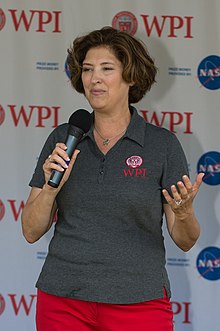Laurie Leshin
| Laurie Leshin | |
|---|---|
 |
|
| Citizenship | United States |
| Fields |
Chemistry Geochemistry Planetary Science |
| Institutions |
Worcester Polytechnic Institute Rensselaer Polytechnic Institute Arizona State University NASA |
| Alma mater |
Arizona State University California Institute of Technology |
Dr. Laurie Leshin is the 16th President of Worcester Polytechnic Institute, and is the first female president in the Institution's 150-year history. Leshin is an accomplished academic and administrative leader, geochemist, and space scientist.
At the helm of WPI since June 1, 2014, President Leshin is focused on elevating the impact of this “technological university with a human heart and a global reach,” believing passionately that the way WPI approaches STEM learning and discovery is the way it should be approached.
Leshin earned her B.S. degree in Chemistry from Arizona State University in Tempe, Arizona, and her M.S. (1989) and Ph.D. (1994) in Geochemistry from the California Institute of Technology in Pasadena, California.
Prior to joining WPI, Leshin served as Dean of the School of Science and Professor of Earth & Environmental Science at Rensselaer Polytechnic Institute, where she led the scientific academic and research enterprise. Leshin’s scientific expertise is in cosmochemistry, and she is primarily interested in deciphering the record of water on objects in the Solar System
Leshin served as the Deputy Associate Administrator for NASA’s Exploration Systems Mission Directorate where she played a leading role in NASA's future human spaceflight endeavors. Her duties included oversight of the planning and execution of the next generation of human exploration systems, as well as the research, robotic and future capabilities development activities that support them. She was also engaged in initiating the development of commercial human spaceflight capabilities to low earth orbit. Prior to joining NASA Exploration, Leshin was the Deputy Director for Science and Technology at NASA’s Goddard Space Flight Center in Greenbelt, Maryland. She oversaw strategy development at the Center, leading an inclusive process to formulate future science and technology goals, and an integrated program of investments aligned to meet those goals. With other NASA Goddard senior managers, she was responsible for effectively executing the Centers’ $3B in programs, and ensuring the scientific integrity of Earth observing missions, space-based telescopes such as the James Webb Space Telescope, and instruments exploring the Sun, Moon, Mercury, Mars, Saturn, comets and more. At NASA Goddard she also served as Director of Sciences & Exploration, overseeing science activities at NASA's largest science Center.
...
Wikipedia
